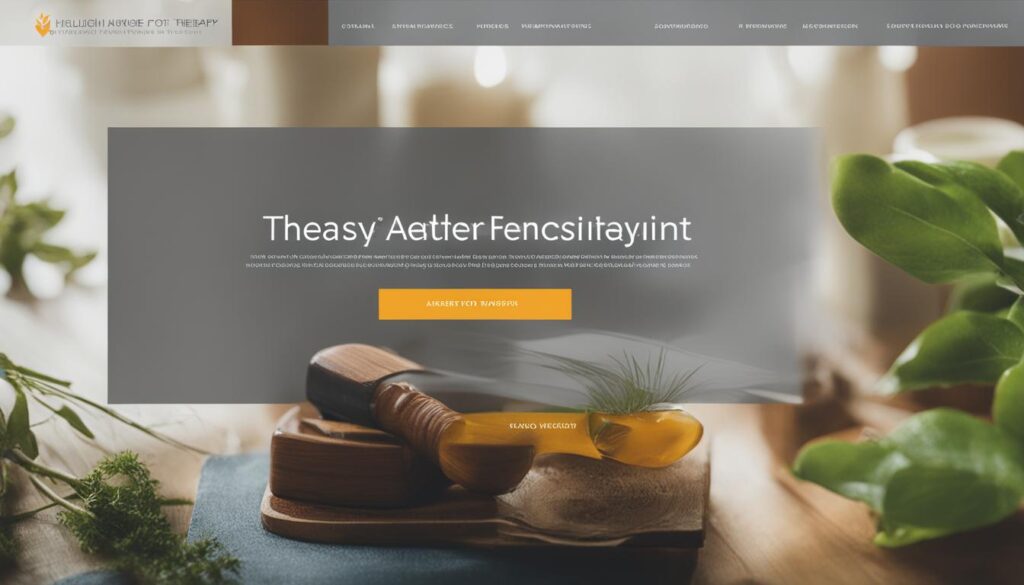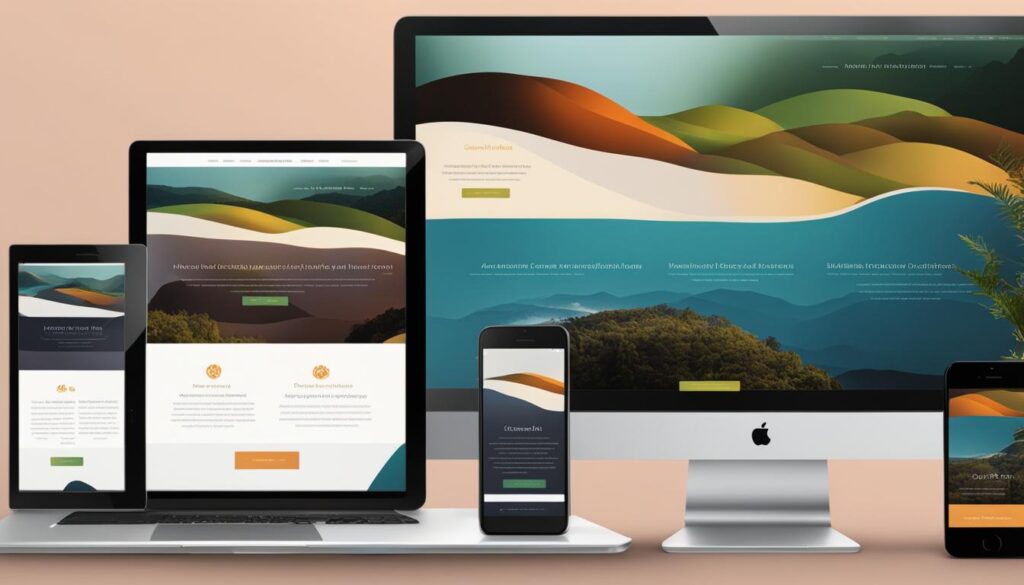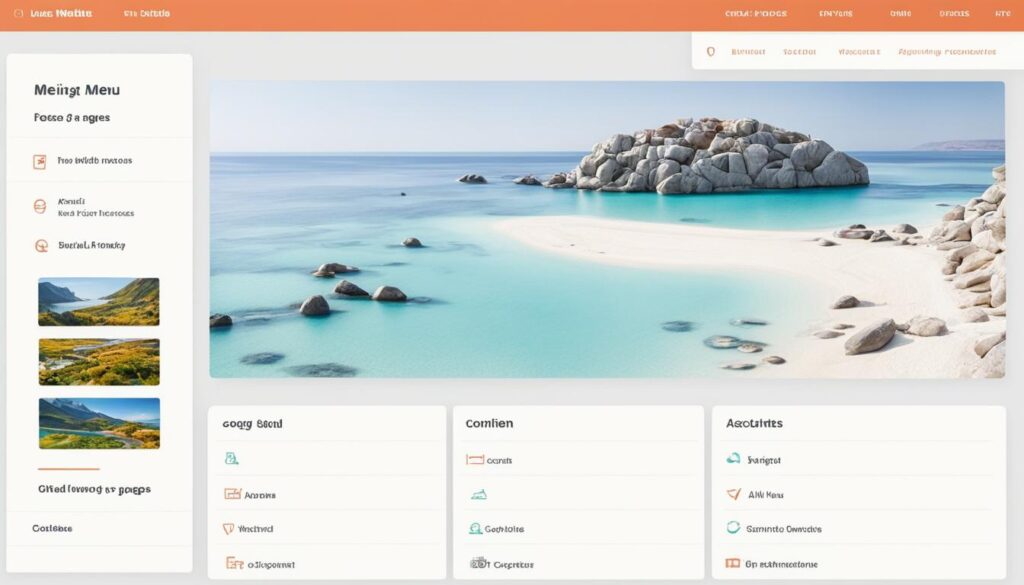In today’s digital world, having a well-designed website is crucial for psychologists to enhance their online presence and attract clients. At WebsiteDesigner.Business, we specialize in creating professional, custom websites that are responsive, SEO-friendly, and user-friendly. Our modern web design solutions are tailored specifically for psychologists, ensuring that your website reflects the unique personality and professionalism of your practice.
With our affordable web design services, you can have a mobile-friendly website that makes a lasting impression on potential clients. Whether you are just starting your therapy practice or looking to revamp your existing website, we are here to help you elevate your online presence and grow your therapy practice.
Key Takeaways:
- Professional website design for psychologists is essential for enhancing online presence and attracting clients.
- Custom website design ensures that your website reflects the unique personality and professionalism of your practice.
- Responsive web design ensures that your website looks and functions flawlessly across different devices, improving user experience.
- SEO-friendly website design optimizes your website for search engines, increasing online visibility.
- User-friendly website design creates a positive user experience and helps potential clients find the information they need easily.
The Power of a Well-Designed Therapy Website
A well-designed therapy website holds immense power in establishing credibility and making a lasting impression on potential clients. It serves as the crucial first point of contact, influencing their decision to choose your valuable psychological services. Attracting and captivating therapy clients begins with an impeccably designed website that leaves a positive and professional impact.
When prospective clients visit your website, they form an immediate perception of your practice based on its visual appeal, functionality, and user experience. A well-designed therapy website conveys professionalism, trustworthiness, and competence, instilling confidence in the minds of potential clients. It showcases your dedication to providing exceptional care and sets you apart from competitors.

Your website acts as a virtual representation of your practice, serving as a marketing tool available 24/7. It allows you to showcase your expertise, specialization, and unique approach to therapy. Through thoughtful design choices, you can create an impactful online presence that resonates with your target audience and compels them to take action.
“A well-designed website is key to establishing credibility and capturing the attention of therapy clients.” – Dr. Sarah Smith, Clinical Psychologist
Investing in professional website design for psychologists is essential for long-term success in today’s digital landscape. By prioritizing the importance of website design, you can attract clients, build trust, and grow your therapy practice exponentially.
Understanding Your Target Audience
Before we delve into the exciting web design trends, it’s vital for psychologists like you to have a deep understanding of your target audience. By comprehending the specific needs and preferences of your therapy clients, you can make design choices that resonate and connect with them on a profound level.
Every therapy client is unique, and their individual requirements should be reflected in the design of your website. Let’s explore some examples of design choices for different clients:
1. Working with Young Adults
When targeting young adults, it’s essential to create a website that portrays a modern and sleek aesthetic. Consider using clean lines, minimalistic layouts, and fonts that exude professionalism. Engaging visuals like high-quality images and videos can capture their attention, while a user-friendly navigation system ensures seamless interaction.
2. Working with Children
Designing a website for children requires a more playful and colorful approach. Incorporate vibrant colors, whimsical illustrations, and interactive elements to engage their imagination. Make sure the website is easy to navigate, with clear labels and intuitive icons that encourage exploration.
3. Working with Older Adults
For clients in the older age group, prioritize simplicity and accessibility. Use larger text sizes, high contrast color combinations, and clear navigation menus to aid readability. Including testimonials from older clients can help establish trust and credibility. Consider adding functionality options like font resizing to accommodate different visual abilities.
Remember, the design choices you make should align with the preferences and needs of your target audience. By tailoring your website to their unique characteristics, you can create a platform that resonates deeply and fosters a connection with your therapy clients.
Let’s take a moment to visualize the importance of understanding your target audience in web design:
| Target Audience | Design Choices |
|---|---|
| Young Adults | Modern and sleek aesthetic with clean lines, minimalistic layouts, and engaging visuals. |
| Children | Playful and colorful approach with vibrant colors, whimsical illustrations, and interactive elements. |
| Older Adults | Simple and accessible design with larger text sizes, high contrast colors, and intuitive navigation. |

By catering to the specific design preferences of your therapy clients, you can create a visually appealing and engaging website that enhances their overall experience. Let’s now explore the exciting web design trends that can elevate your practice and attract more clients.
Trend #1: Responsive Design
In today’s digital age, it’s imperative for therapists to have a website that caters to the diverse range of devices potential clients use. This is where responsive design comes into play. Responsive design ensures that your website looks and functions flawlessly on smartphones, tablets, and desktops. By optimizing your website for different devices, you can create a seamless user experience and capture the attention of your target audience, regardless of the device they are using.
When it comes to implementing responsive design, using responsive WordPress themes can provide a solid foundation for your therapist’s website. One such popular theme is the Hello Elementor WordPress theme.

With Hello Elementor, you can easily create a visually stunning and mobile-friendly website that adapts to different screen sizes. This responsive WordPress theme offers a range of customizable elements and intuitive drag-and-drop functionality, allowing you to design and optimize your website without the need for coding skills.
By embracing responsive design and utilizing responsive WordPress themes, you can ensure that your therapist’s website delivers a seamless and user-friendly experience across all devices, increasing engagement and attracting more potential clients.
Trend #2: Embrace Minimalism
When it comes to web design for psychologists, embracing minimalism is a trend that cannot be ignored. Minimalistic web design creates a sense of professionalism and clarity, making your therapist’s website visually appealing and user-friendly.
A clean layout with ample white space and a focus on essential elements is key to achieving a minimalistic design. By avoiding overwhelming visitors with excessive text or cluttered design elements, you can create a website that presents information in a clear and concise manner, enhancing the user experience.
To give you a better idea, here’s a breakdown of the essential elements that contribute to a minimalistic web design:
| Element | Description |
|---|---|
| Whitespace | Ample whitespace helps create a sense of openness and allows content to breathe. |
| Simple Typography | Use clean and easily readable fonts to enhance the clarity of your text. |
| Clear Navigation | An intuitive and straightforward navigation menu helps visitors navigate your website effortlessly. |
| Limited Color Palette | Choose a few colors that complement your branding and maintain consistency throughout your website design. |
| Concise Content | Present your content in a concise and organized manner, using headings and bullet points to improve readability. |
| High-Quality Imagery | Opt for high-quality images that are relevant to your therapy practice, evoking emotions and connecting with potential clients. |
By incorporating these essential elements, you can achieve a minimalistic web design that not only looks visually appealing but also enhances the user experience. Remember, less is more when it comes to delivering a powerful message and creating a lasting impression.

Trend #3: Engaging Visuals
Visuals are a powerful tool for capturing the attention of potential clients and making a lasting impression. By incorporating high-quality images and videos into your therapy website, you can create an immersive experience that resonates with visitors and helps build trust. Authentic visuals that showcase your practice and evoke emotions can greatly enhance the connection with your clients.
When selecting images and videos for your website, it’s important to choose ones that are relevant to your therapy practice and align with the overall theme and message you want to convey. Whether it’s a serene and peaceful image that represents mental well-being or a video testimonial that showcases the positive impact you’ve had on your clients, these visuals should speak directly to the needs and aspirations of your target audience.
High-quality images not only enhance the visual appeal of your website but also contribute to its professionalism. Clear and captivating visuals can create a sense of credibility and expertise, making visitors more inclined to explore your services further. Investing in professional photography or sourcing stock images from reputable platforms can help ensure that your visuals are of the highest quality.
When using videos on your website, consider incorporating them in areas where they will have the most impact, such as the homepage or specific service pages. Videos allow you to tell your story in a dynamic and engaging way, giving potential clients a glimpse into your personality and approach. This personal connection can be instrumental in building trust and encouraging visitors to take the next step in contacting you.
To further optimize your visuals and ensure a seamless user experience, pay attention to the file sizes and loading times of your images and videos. High-quality visuals are important, but they should not compromise the overall performance of your website. Compressing images and utilizing video hosting platforms can help strike the right balance between visual excellence and optimal website performance.
Trend #4: Clear and Intuitive Navigation
Good navigation is crucial for a therapist’s website. Clear and concise navigation menus, logically organized content, and an intuitive user experience can guide potential clients through the website and help them find the information they need easily. A well-designed navigation system enhances the user experience and encourages visitors to explore further, ultimately increasing the chances of converting them into clients.
When creating navigation menus, it’s important to use descriptive labels that are easy to understand. Avoid using jargon or ambiguous terms that may confuse visitors. Instead, opt for clear and straightforward wording that accurately represents the page or section it leads to. Consistency in navigation throughout the website also helps users navigate intuitively, as they know what to expect from each menu item.
Logical organization is key to a well-structured website. By categorizing content into logical sections and sub-sections, visitors can easily locate the information they are looking for. This organization not only improves user experience but also helps search engines understand the content better, thereby improving search engine optimization (SEO) rankings.
One effective way to enhance navigation is by incorporating drop-down menus or expanding sections. This allows visitors to access specific information without having to navigate through multiple pages. Additionally, incorporating search functionality within the navigation menu enables users to quickly find desired content by typing relevant keywords.
A clear and intuitive navigation system is like a compass that guides potential clients through your website, making it easier for them to explore your services and understand what you offer. It not only improves user experience but also conveys professionalism and credibility, giving visitors a positive impression of your practice.
To further improve user experience, consider adding visual cues such as breadcrumbs, indicating the user’s location within the website. This helps users orient themselves and navigate back to previous pages if needed. Additionally, using a sticky navigation menu that remains visible as users scroll down the page ensures easy access to essential pages or contact information.
Example of a well-structured navigation menu:
| Home | About | Services | Blog | Contact |
|---|---|---|---|---|
| Overview | About Us | Therapy Options | Tips & Advice | Get in Touch |
| Our Team | Approach | Pricing | Success Stories | Location & Hours |
| Testimonials | Philosophy | Appointment Booking |

Trend #5: Integrating Client Testimonials
Client testimonials are a powerful tool for psychologists to showcase their positive impact on previous clients and build trust with potential clients. By strategically integrating client testimonials throughout their website, psychologists can provide social proof and demonstrate the value they bring to their therapy practice.
Testimonials serve as a form of social proof, assuring potential clients that others have had a positive experience working with the psychologist. They create a sense of credibility and trust, influencing potential clients to take the next step and reach out for therapy.
When incorporating client testimonials, it’s essential to be HIPAA compliant and respect clients’ privacy. Testimonials should focus on the positive impact the therapist has had on the client’s well-being without revealing any sensitive or personally identifiable information.
Showcasing Real-World Success Stories
One effective way to integrate client testimonials is by featuring real-world success stories. These compelling narratives highlight how the therapist’s expertise and guidance have positively impacted individuals’ lives.
“Working with [Psychologist Name] has been life-changing. Their compassionate approach and deep understanding have helped me overcome my personal challenges and achieve significant personal growth.” – Jane Smith
The use of quotes, like the one above, can help testimonials stand out and capture the attention of potential clients. The quoted statement should be formatted as a blockquote to clearly separate it from the main content, making it more visually appealing.
Strategic Placement
Psychologists should strategically place client testimonials throughout their website to maximize their impact. Testimonials can be included on the homepage, service pages, or a dedicated testimonials page. They can also be placed next to relevant information or service offerings to further reinforce the positive experiences of previous clients.
By showcasing client testimonials in key locations across the website, psychologists can effectively build trust and inspire potential clients to take action.
Creating a Compelling Testimonials Page
A dedicated testimonials page provides a centralized location for potential clients to explore the positive experiences of others. This page can include a collection of testimonials from different clients, showcasing the wide range of individuals who have benefited from the therapist’s services.
To enhance the credibility of the testimonials, psychologists can include the client’s name, occupation, and an optional photo. This additional information adds authenticity and makes the testimonials more relatable to potential clients.
Here’s an example of how a testimonials page could be structured:
| Client Name | Occupation | Testimonial |
|---|---|---|
| John Doe | Software Engineer | “Working with [Psychologist Name] has been transformative. Their guidance and empathy have helped me overcome my anxiety and regain control of my life.” |
| Jane Smith | Teacher | “I highly recommend [Psychologist Name]. Their expertise and support have been instrumental in helping me navigate through tough times and find inner strength.” |
By integrating client testimonials that highlight the therapist’s positive impact, psychologists can effectively build trust, showcase their expertise, and attract potential clients who resonate with the experiences of previous clients.

Optimizing for Search Engines
When it comes to enhancing the online visibility of a therapist’s website, search engine optimization (SEO) plays a vital role. Implementing SEO strategies can significantly improve the chances of potential clients finding the website and ultimately increase the therapist’s client base.
Optimizing Meta Tags, Headings, and Content
Meta tags, headings, and content are key elements that search engines use to understand and categorize website content. By optimizing these components, therapists can improve their website’s search rankings and attract organic traffic.
Starting with meta tags, it is crucial to ensure that each page has a unique meta title and meta description that accurately represent the content. Including relevant keywords that potential clients may use in their search queries can help search engines understand the website’s relevance. For example:
“Customized Therapy Services – Experienced Psychologist in Los Angeles | YourPractice”
“Individual and Couples Counseling – Expert Therapist in New York | YourPractice”
In addition to meta tags, optimizing headings is another essential aspect of SEO. The proper use of heading tags (H1, H2, etc.) can help organize the content and highlight important information. It is essential to include relevant keywords in the headings to improve search engine visibility.
When it comes to content, creating high-quality, informative, and engaging text is crucial. Using keywords naturally throughout the content can enhance its SEO value. However, it is vital to maintain readability and avoid keyword stuffing, which can have a negative impact on search rankings.
Utilizing SEO Plugins for Simplified Optimization
For therapists who may not have technical expertise in SEO, utilizing SEO plugins can simplify the optimization process and provide valuable insights. One highly recommended SEO plugin is Rank Math. This powerful tool offers features such as keyword optimization, XML sitemap generation, and advanced analytics to help therapists track their website’s performance.
By leveraging the capabilities of SEO plugins like Rank Math, therapists can effectively optimize their websites for search engines, improve their online visibility, and ultimately attract more potential clients.
Next, let’s explore how therapists can customize their WordPress websites with plugins and themes to further enhance their online presence.
| SEO Optimization Tips | Benefits |
|---|---|
| Use relevant keywords in meta tags, headings, and content. | Improves search engine visibility and attracts organic traffic. |
| Create unique and descriptive meta titles and meta descriptions for each page. | Enhances website relevance in search engine results. |
| Properly utilize heading tags (H1, H2, etc.) throughout the content. | Organizes content and highlights important information. |
| Write high-quality, keyword-rich content that is informative and engaging. | Increases the website’s SEO value and provides value to visitors. |
| Use SEO plugins like Rank Math for simplified optimization and insights. | Simplifies the optimization process and provides valuable analytics. |

Customizing WordPress with Plugins and Themes
When it comes to customizing your therapist’s website, WordPress offers an array of powerful tools, including plugins and themes, to help you achieve a unique and professional design. With WordPress customization, you can align your website with your branding and cater to your specific requirements.
One of the standout plugins for customizing your WordPress website is Elementor Pro. This intuitive and feature-rich plugin allows you to create stunning custom designs without any coding skills. With its drag-and-drop functionality, you have the freedom to design your website exactly the way you envision it, all while maintaining full control over the visual elements. Whether it’s creating eye-catching layouts or adding interactive features, Elementor Pro opens up a world of possibilities for your therapist’s website.
To complement your customization efforts, the Hello Elementor Theme can be your go-to choice. This lightweight and user-friendly theme seamlessly integrates with the Elementor Pro plugin, providing a solid foundation for your custom design. With Hello Elementor, you can be confident that your website will be optimized for speed and performance, while still offering a visually appealing and engaging user experience.
In addition to plugins and themes, you can enhance the functionality and organization of your therapist’s website with the help of Advanced Custom Fields. This plugin allows you to easily create custom fields for your posts, pages, and custom post types. By adding specific fields to your website, you can efficiently manage and display relevant information, such as contact details, specialties, or pricing. Advanced Custom Fields gives you the flexibility to tailor your website to your specific needs and empower your clients with the information they seek.
Key Benefits of Customizing WordPress with Plugins and Themes:
- Complete control over the design and visual elements of your therapist’s website
- No coding skills required, thanks to the user-friendly interface of Elementor Pro
- Seamless integration between Elementor Pro and the Hello Elementor Theme, ensuring a cohesive and visually appealing design
- Enhanced functionality and organization with the help of Advanced Custom Fields
By taking advantage of WordPress customization options and utilizing the power of plugins and themes like Elementor Pro, Hello Elementor, and Advanced Custom Fields, you can create a truly unique and professional website for your therapy practice. Customize your website to reflect your brand, engage your audience, and promote your services effectively.
Get started with WordPress customization today and unlock the full potential of your therapist’s website.
| Plugins and Themes | Key Features |
|---|---|
| Elementor Pro | – Drag-and-drop interface for easy website design – Customizable layouts and features – Responsive design for optimal viewing across devices |
| Hello Elementor Theme | – Lightweight and optimized for performance – Seamless integration with Elementor Pro – Clean and modern design |
| Advanced Custom Fields | – Create custom fields for posts, pages, and custom post types – Efficiently manage and display specific information – Tailor your website to your unique needs |
Unlock the full potential of your therapist’s website with WordPress customization, plugins, and themes. Create a visually stunning and functional website that reflects your brand and engages your audience effectively.

Conclusion
A well-designed website plays a pivotal role in elevating a psychologist’s online presence and attracting more clients. By implementing the web design trends and tips discussed in this article, therapists can create a modern and professional website that effectively communicates their expertise and helps grow their therapy practice.
Web design for psychologists should prioritize responsiveness, ensuring that the website looks good and functions seamlessly across different devices. Embracing minimalism and utilizing clean layouts with essential elements can enhance the user experience and create a sense of professionalism. Engaging visuals, such as high-quality images and videos, can effectively connect with potential clients and build trust.
Clear and intuitive navigation is crucial for guiding visitors through the website and improving their experience. Integrating client testimonials strategically throughout the website helps build trust and showcase the positive impact the psychologist has had on previous clients. Optimizing the website for search engines using techniques like meta tag optimization and SEO plugins can enhance online visibility.
To customize their websites, psychologists can take advantage of WordPress plugins and themes like Elementor Pro, Hello Elementor Theme, and Advanced Custom Fields. These tools offer flexibility and freedom in creating stunning custom designs without the need for coding skills.
Visit our website WebsiteDesigner.Business to explore our web design plans tailored to your needs and elevate your psychology practice. With our expertise, you can create a website that effectively represents your professionalism and helps you grow your therapy practice.
FAQ
Why is web design important for psychologists?
Web design is important for psychologists because it helps establish credibility, make a positive impression on potential clients, and enhance their online presence.
How does a well-designed therapy website benefit psychologists?
A well-designed therapy website can capture the attention of potential clients, establish trust and credibility, and serve as the first point of contact in attracting new clients.
How should psychologists understand their target audience?
Psychologists should understand their target audience by identifying their specific needs, preferences, and demographics in order to tailor their website design choices accordingly.
Why is responsive design important for therapists’ websites?
Responsive design is crucial because it ensures that a website looks and functions flawlessly on different devices, such as smartphones, tablets, and desktops.
What is the benefit of a minimalistic web design for psychologists?
A minimalistic web design creates a sense of professionalism and clarity, providing a visually appealing and user-friendly experience for potential clients.
How can engaging visuals enhance a therapist’s website?
Engaging visuals, such as high-quality images and videos, can help potential clients connect with the therapist’s practice, evoke emotions, and build trust.
Why is clear and intuitive navigation important for a therapist’s website?
Clear and intuitive navigation improves the user experience by helping potential clients easily find the information they need and navigate through the website smoothly.
How can integrating client testimonials benefit psychologists?
Integrating client testimonials throughout the website provides social proof, builds trust and credibility, and showcases the positive impact a therapist has had on previous clients.
Why is optimizing a therapist’s website for search engines crucial?
Optimizing a therapist’s website for search engines improves its online visibility, increases the chances of potential clients finding the website, and enhances its search engine rankings.
How can WordPress customization options benefit psychologists?
WordPress customization options, such as plugins and themes like Elementor Pro and the Hello Elementor theme, allow psychologists to align their website with their branding and unique requirements without coding skills.
How can a well-designed website help psychologists grow their therapy practice?
A well-designed website effectively communicates a psychologist’s expertise, attracts more clients, and elevates their online presence, ultimately helping them grow their therapy practice.

Leave a Reply